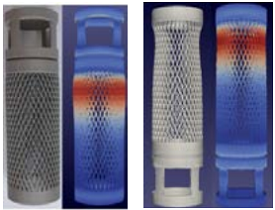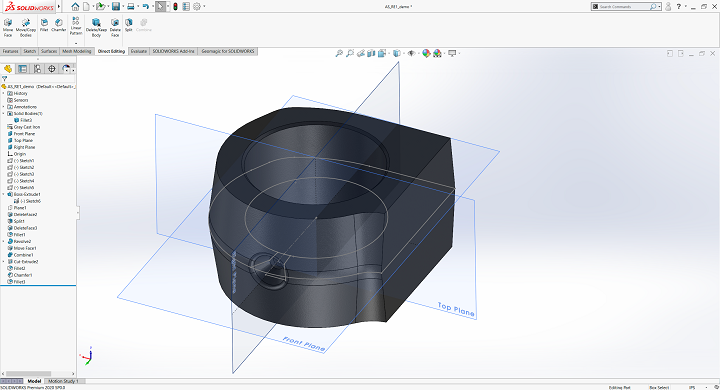SmarTech Analysis has put out its most recent report, “Opportunities in Additive Manufacturing Software Markets 2020”, which relays some surprising data about the segment. The market research firm anticipates pretty rapid growth for the additive manufacturing (AM) software sector, with revenues increasing from $460 million in 2020 to an impressive $3.7 billion by 2027.
In this, the first study of the AM software segment since SmarTech’s pioneer report in 2017, analyst Scott Dunham examines the current state and future of AM software functions, including process simulation, intelligent design optimization AM execution systems. A broad conclusion from the report is the fact that 3D printing software is becoming less of a niche part of AM and industrial manufacturing as a whole and becoming more significant and robust overall.

ANSYS software compensating for distortions in metal laser powder bed fusion 3D printing. (Image courtesy of ANSYS.)
AM software has obviously become more advanced, with significant progress being made in terms of metal and polymer AM simulation, as well as quality control technology. With the ANSYS acquisition of 3DSIM, Hexagon developing its own metal AM simulation software, and Velo3D selling its Assure software, we know that software is now crucial to repeatability and first-time-right parts in 3D printing.
At the same time, it is becoming increasingly integrated into leading CAD/CAM and PLM software. Siemens, for instance, began incorporating AM capabilities into its design tools via Materialise and Frustum products in 2017, while Dassault has continually added 3D printing functions to SOLIDWORKS. The fact that Autodesk acquired Netfabb and is attempting to link all of its CAD and manufacturing tools into a single ecosystem is further evidence of this trend. The report suggests that, in the course of the past three years, AM software is improving manufacturing outcomes for users by providing better connectivity and cohesion from design through to production.
In particular, print preparation software is being incorporated into other areas of the AM software chain so that functions such as slicing, STL repair, support structure and orientation strategy will fit into other software points in the design-to-production workflow. According to SmarTech, while major AM software tools like Materialise Magics, Autodesk Netfabb and 3D Systems 3DXpert will continue to widespread use, there will be pressure to lower costs that will see users perform the functions they achieve with these programs in other more condensed software platforms.
All of SmarTech’s latest reports also take the COVID-19 pandemic into account, recognizing that, on the one hand, AM has played and will play an increased role in establishing new supply chains. In the case of AM software, the company sees software used “as never before” as this new supply chain is further developed. Dunham suggests that AM software will bring order to manufacturing, while diversifying supply chains and providing a backstop against disruptions for firms who rely on Asia for manufacturing.
The report is made up of a detailed study of market sizing with ten-year market forecasts that segments the industry into software tool type, adopting end-user industry, and opportunities for AM software per 3D printing technology segment, including polymers and metals. SmarTech suggests that its AM software reports are now used throughout the AM industry by companies pursuing an off-the-shelf resource for extensive market data and forecasts. Companies discussed in the report include Autodesk, 3D Systems, Materialise, Siemens, AMFG and Dassault Systèmes.
The full report, as well as a summary and table of contents, can be found at the SmarTech Analysis website here.
Subscribe to Our Email Newsletter
Stay up-to-date on all the latest news from the 3D printing industry and receive information and offers from third party vendors.
Print Services
Upload your 3D Models and get them printed quickly and efficiently.
You May Also Like
The Market and Industry Potential of Multi-Material 3D and 4D Printing in Additive Electronics
Additive manufacturing leverages computer-based software to create components for products by depositing either dielectric or conductive materials, layer by layer, into different geometric shapes. Since its birth in the 1980s,...
3DPOD 262: Bio-inspired Design for AM with Dhruv Bhate, Arizona State University
Dhruv Bhate is an associate professor at Arizona State University. There, he looks at structures, materials, and design. Previously, he worked at PADT as well as in the semiconductor and...
3DPOD 261: Tooling and Cooling for AM with Jason Murphy, NXC MFG
Jason Murphy´s NXC MFG (Next Chapter Manufacturing) is not a generalist service; instead, the company specializes in making tooling. Using LPBF and binder jet, the company produces some of the...
3DPOD 260: John Hart on VulcanForms, MIT, Desktop Metal and More
John Hart is a Professor at MIT; he´s also the director of the Laboratory for Manufacturing and Productivity as well as the director of the Center for Advanced Production Technologies....


































